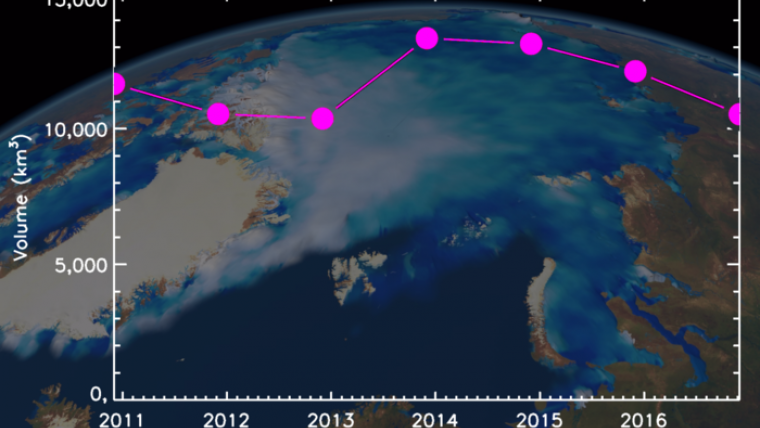Arctic Sea-ice Growth Slower than Usual
ESA’s CryoSat satellite has found that the Arctic has one of the lowest volumes of sea ice of any November, matching record lows in 2011 and 2012. Early winter growth of ice in the Arctic has been about 10% lower than usual. The Arctic usually gains about 161km3 of ice per day in November. This year’s growth has been 139km3 per day, with a total ice volume estimated to have accumulated to 10,500km3 by the end of the month. Although sea ice in the central Arctic is currently thicker than it was in 2011, there is far less ice in more southerly regions such as the Beaufort, East Siberian and Kara Seas.
CryoSat carries a radar altimeter that can measure the surface height variation of ice in fine detail, allowing scientists to record changes in its volume with unprecedented accuracy. These observations are vital for tracking climate change and are an essential resource for maritime operators who increasingly navigate the icy waters of Earth’s polar regions.
Thicker Ice
The US National Snow and Ice Data Centre reported that the area of the Arctic covered by sea ice fell to 4.1 million km2 in September this year – slightly less than the sea-ice extent in September 2011. But CryoSat shows that the ice was thicker at the end of summer than in most other years, at 116cm on average. This means there was substantially more ice this year than in 2011. Thicker ice can occur if melting is lower, or if snowfall or ice compaction is higher.
As demand for information on Arctic conditions increases, CryoSat has become an essential source of information for polar stakeholders, ranging from ice forecasting services to scientists studying the effects of climate change. According to CPOM Director and principal scientific advisor to the CryoSat mission, Professor Andrew Shepherd, in its short, six years of life, researchers have learnt more about Arctic sea ice from CryoSat than from any other satellite mission.
CPOM plans to release a complete assessment of 2016 sea ice conditions in the coming weeks.

Value staying current with hydrography?
Stay on the map with our expertly curated newsletters.
We provide educational insights, industry updates, and inspiring stories from the world of hydrography to help you learn, grow, and navigate your field with confidence. Don't miss out - subscribe today and ensure you're always informed, educated, and inspired by the latest in hydrographic technology and research.
Choose your newsletter(s)
























